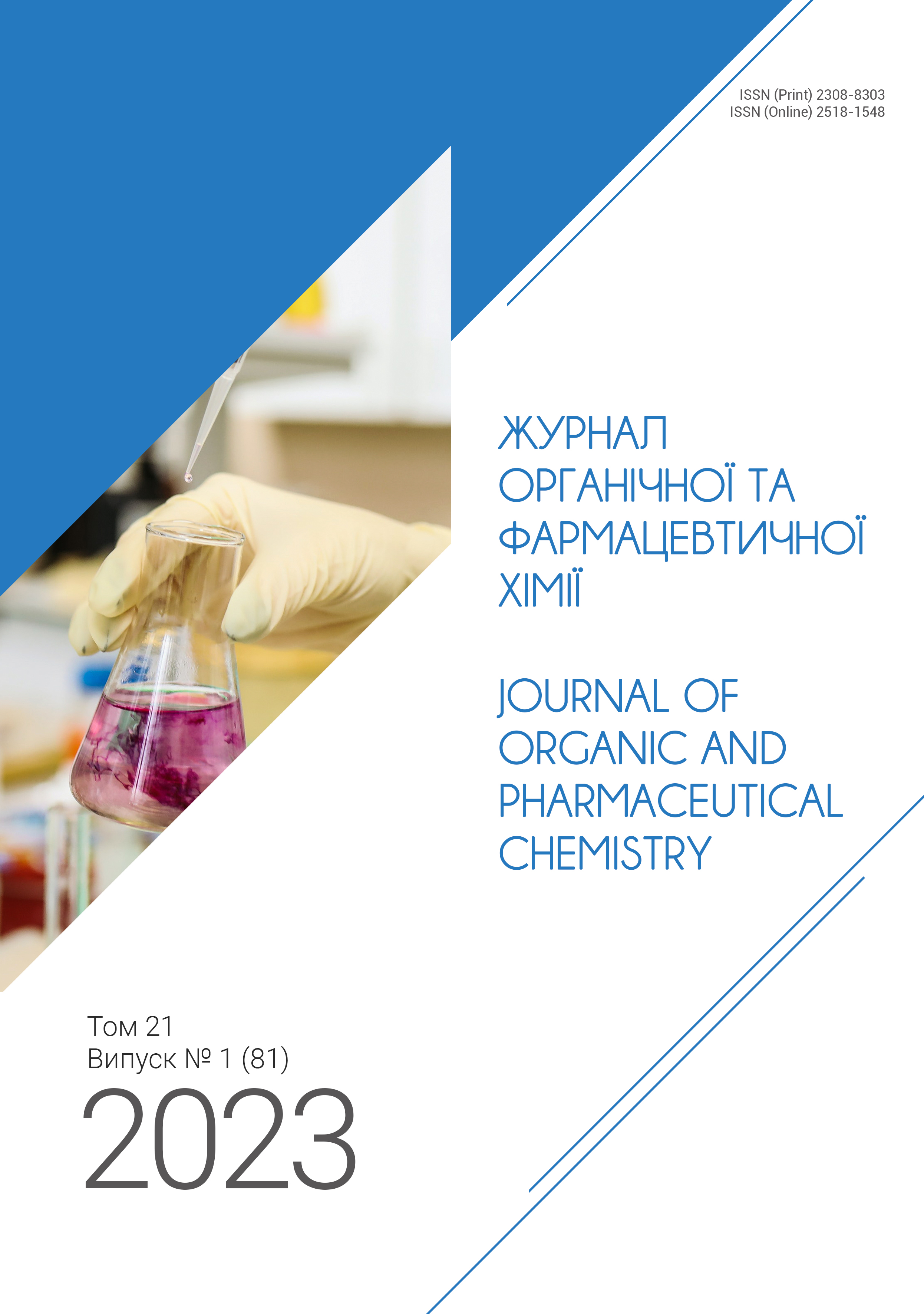Chemical components of essential oils from aerial parts of Pycnanthemum virginianum and P. californicum (Lamiaceae) plants
DOI:
https://doi.org/10.24959/ophcj.23.273810Keywords:
introduced plants, Pycnanthemum, components of essential oils, GC-MSAbstract
Aim. The research is aimed at determining the qualitative and quantitative content of essential oils in the aerial part of two species of the genus Pycnanthemum Michx. (Lamiaceae) – P. virginianum (L.) T. Durand & B.D. Jacks. ex B.L. Rob & Fernald and P. californicum Norr. exDurand. The plants were introduced in the M. M. Gryshko National Botanical Garden of National Academy of Sciences of Ukraine (Forest-Steppe zone). These are representatives of the flora of North America, and they are little known in Ukraine. Plants have useful medicinal and nutritional properties, but the biochemical composition of their essential oils has not been sufficiently studied in the world.
Materials and methods. In the experiment, the aerial herbal part of plants collected during the flowering phase was used. The quantitative content of the essential oil was determined by the hydrodistillation method, and its qualitative characteristics were found by the GC-MS analysis. The chromatographic profile was obtained on an Agilent Technologies 7890. The component composition of the essential oil was determined on a gas chromatograph with a HP 6890 mass spectrometric detector with a mass spectrometric detector 5973. We used a mass spectrometric detector 1.6 – 800 a.o.m., EI ionization, SIM & Scan mode, “Hewlett Packard”, USA. Identification of essential oil components was performed using the NIST mass spectrum library in combination with AMDIS content-time identification programs.
Results and discussion. P. virginianum was found to produce 1.96 ± 0.17 % of essential oil, in which 12 compounds out of 13 were identified; P. californicum had 2.66 ± 0.13 % of essential oil, 13 compounds out of 15 were identified. The essential oil samples obtained have pulegone as the dominant component: P. virginianum – 44.65 %, P. californicum – 86.07 %. In addition to it, they also contain thymol, myrcene, 1.8-cineole, menthone, limonene and other compounds.
Conclusions. For the first time, the qualitative and quantitative composition of the essential oils of plants of P. virginianum and P. californicum species introduced in Ukraine has been determined. The results obtained indicate that when introduced plants have a high biosynthesizing ability to produce essential oil. Pulegone has been found to be the dominant component; therefore, the essential oil can be classified as a pulegone-type essential oil. We believe that the raw material of P. virginianum and P. californicum are potentially suitable for use in perfumery, cosmetics, aromatherapy, personal care products, dentistry, and in the pharmaceutical and food industries.
Supporting Agency
- The authors received no specific funding for this work.
Downloads
References
- Dein, M. Key Odorants of Pycnanthemum incanum and Stereochemistry of Chiral Compounds. Master's Thesis, University of Tennessee, 2019. https://trace.tennessee.edu/utk_gradthes/5523.
- Ebadollahi, A; Ziaee, M; Palla, F. Essential oils extracted from different species of the Lamiaceae plant family as prospective bioagents against several detrimental pests. Molecules 2020, 25 (7), 1556. https://doi.org/10.3390/molecules25071556.
 |
| 
- Karpinski, T. M. Essential oils of Lamiaceae family plants as antifungals. Biomolecules 2020, 10 (1), 103. https://doi.org/10.3390/biom10010103.
 |
| 
- Shu, C.-K.; Lawrence, B.M.; Miller, K.L. Chemical Composition of the Essential Oil of Pycnanthemum floridanum E. Grant and Epling. J. Essent. Oil Res. 1994, 8 (5), 529–531. https://doi.org/10.1080/10412905.1994.9698442.
 |
| 
- Dein, M.; Munafo, J.P. Characterization of key odorants in hoary mountain mint, Pycnanthemum incanum. J. Agric. Food Chem. 2019, 67 (9), 2589–2597. https://doi.org/10.1021/acs.jafc.8b06803.
 |
|  |
| 
- Dein, M.; Munafo, J. P. Characterization of Odorants in Loomis’ Mountain Mint, Pycnanthemum loomisii. J. Agric. Food Chem. 2022, 70 (45), 14448–14456. https://doi.org/10.1021/acs.jafc.2c05492.
 |
| 
- Setzer, W. N.; Duong, L.; Pham, T.; Poudel, A.; Nguyen, C.; Mentreddy, S. R. Essential Oils of Four Virginia Mountain Mint (Pycnanthemum virginianum) Varieties Grown in North Alabama. Plants 2021, 10, 1397. https://doi.org/10.3390/plants10071397.
 |
| 
- The Plant List: Pycnanthemum Michaux. http://www.theplantlist.org/tpl1.1/search?q=Pycnanthemum (accessed Oct 20, 2022).
- Weakley, A. S. Flora of the Carolinas, Virginia, Georgia, northern Florida, and surrounding areas. Working Draft of 7 April 2008. https://ncbg.unc.edu/wp-content/uploads/sites/963/2020/06/WeakleyFlora_2008-Apr.pdf (accessed Feb 28, 2022).
- Cozzo, D. N. Ethnobotanical classification system and medical ethnobotany of the eastern band of the Cherokee Indians. University of Georgia, Athens, Georgia, USA, 2004. https://getd.libs.uga.edu/pdfs/cozzo_david_n_200405_phd.pdf (accessed Sep 09, 2022).
- Small, E. Mountain Mint. North American Cornucopia: Top 100 Indigenous Food Plants, 1st Ed. CRC Press: 2013, 463–466. https://doi.org/10.1201/b15818.
- Felter, H. W.; Lloyd, J. U. King's American Dispensatory. Cincinnatti, USA: Ohio Valley Co, 1898. Scan version by H. Kress https://www.henriettes-herb.com/eclectic/kings/pycnanthemum.html (accessed 2023-02-02).
- Jenderek, M. M.; Holman, G. E.; Ellis, D. D.; Reed, B. M. Long-term preservation of Pycnanthemum genetic resources. In Book of Abstracts, World Congress on In Vitro Biology Meeting, Bellevue, WA, United States, June 3-7, 2012.
- Ombalo (m'yata bolotna, bloshyna, bloshnitsa): shcho tse take, chym zaminyty, osoblyvosti vyroshchuvannya, zastosuvannya [Ombalo (swamp mint, flea): what it is, what to replace it with, features of cultivation, application, in Ukrainian]. https://release.com.ua/?p=37313 (accessed Aug 17, 2022).
- El-Ghorab, A. H. The Chemical Composition of the Mentha pulegium L. Essential Oil from Egypt and its Antioxidant Activity. J. Essent. Oil-Bear. Plants 2006, 9 (2), 183-195. https://doi.org/10.1080/0972060X.2006.10643491.

- Bouyahya, A.; Et-Touys, A.; Bakri, Y.; Talbaui, A.; Fellah, H.; Abrini, J.; Dakka, N. Chemical composition of Mentha pulegium and Rosmarinus officinalis essential oils and their antileishmanial, antibacterial and antioxidant activities. Microb. Pathog. 2017, 111, 41-49. https://doi.org/10.1016/j.micpath.2017.08.015.
 |
|  |
| 
- Nickavar, B.; Jabbareh, F. Analysis of the Essential Oil from Mentha pulegium and Identification of its Antioxidant Constituents. J. Essent. Oil-Bear. Plants 2018, 21 (1), 223–229. https://doi.org/10.1080/0972060X.2018.1433073.

- Agnihotri, V. K.; Agarwal, S. G.; Dhar, P. L.; Thappa, R. K.; Baleshwar; Kapahi, B. K.; Saxena, R. K.; Qazi, G. N. Essential oil composition of Mentha pulegium L. growing wild in the North-Western Himalayas India. Flavour Fragr. J. 2005, 20 (6), 607–610. https://doi.org/10.1002/ffj.1497.
- Yasa, H.; Onar, H. C.; Yusufoglu, A. S. Chemical Composition of the Essential Oil of Mentha pulegium L. from Bodrum, Turkey. J. Essen. Oil-Bear. Plants 2015, 15 (6), 1040–1043. https://doi.org/10.1080/0972060X.2012.10662609.
 |
| 
- Da Rocha, M. S.; Dodmane, P. R.; Arnold, L. L.; Pennington, K. L.; Anwar, M. M.; Adams, B. R.; Taylor, S. V.; Wermes, C.; Adams, T. B.; Cohen, S. M. Mode of Action of Pulegone on the Urinary Bladder of F344 Rats. Toxicol. Sci. 2012, 128 (1), 1-8. https://doi.org/10.1093/toxsci/kfs135.
 |
| 
Downloads
Published
How to Cite
Issue
Section
License
Copyright (c) 2023 National University of Pharmacy

This work is licensed under a Creative Commons Attribution 4.0 International License.
Authors publishing their works in the Journal of Organic and Pharmaceutical Chemistry agree with the following terms:
1. Authors retain copyright and grant the journal the right of the first publication of the work under Creative Commons Attribution License allowing everyone to distribute and re-use the published material if proper citation of the original publication is given.
2. Authors are able to enter into separate, additional contractual arrangements for the non-exclusive distribution of the journal’s published version of the work (e.g., post it to an institutional repository or publish it in a book) providing proper citation of the original publication.
3. Authors are permitted and encouraged to post their work online (e.g. in institutional repositories or on authors’ personal websites) prior to and during the submission process, as it can lead to productive exchanges, as well as earlier and greater citation of published work (see The Effect of Open Access).















